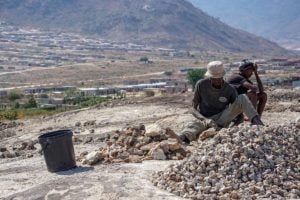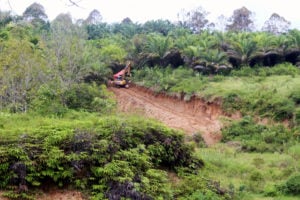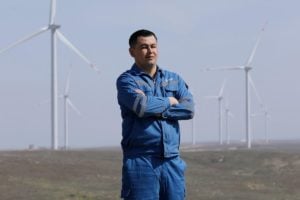China’s mineral resources law serves as the legal cornerstone of the sustainable development of its mining sectors. Since it came into effect in 1986, the law has been revised twice, in 1996 and 2009. After 15 years, the draft of the third revision has added a chapter on “Ecological Restoration of Mining Areas”. This new chapter marks a significant step towards addressing environmental concerns over mining.
It requires mining companies to take effective measures to avoid or reduce damage to ecosystems. Furthermore, ecological restoration should be undertaken when mining activities result in ecological damage. For the first time in Chinese law, it mandates that mining companies prepare ecological restoration plans before mining begins. This requirement could help ensure early integration of environmental considerations, facilitating the identification of potential impacts and mitigation measures to prevent irreversible ecosystem damage.
Despite this, the law represents a missed opportunity to require companies throughout the entire supply chain to carry out due diligence. The requirements for community engagement and public consultation are insufficient, which entails a risk that local communities affected by mining remain bystanders rather than active stakeholders.
Highlights of the revision
The emphasis on the prevention of ecological damage is a major highlight of the revision. It requires mining companies to implement effective measures to minimise damage to ecosystems, such as forests and grasslands. It mandates that they use environmentally friendly techniques, equipment, and technologies. They must also take measures to protect ground water resources, implement safety measures for workers, and prevent environmental pollution before or after a mine closes.
This demonstrates an ambition to reduce the environmental footprint of mining activities and mitigate ecological degradation. By adhering to prevention and mitigation measures, mining companies can minimise negative impacts on the environment and local communities, and uphold ethical business practices.
The revision stipulates that the obligation of ecological restoration changes accordingly when the mineral-exploitation rights change. This means when a mineral-exploiting company transfers its mineral-exploitation rights to another company, the ecological-restoration obligation is transferred too. This makes it harder for mining companies to evade responsibilities and increases the likelihood that restoration efforts will be carried through to completion.
However, the revision does not provide any standards for such ecological restoration. Instead, it states that the relevant ministries “shall formulate technical specifications”. This lack of clear standards could potentially result in ineffective implementation.
Further, the penalties established in the draft revision should be strengthened to make them effective deterrents. For example, the fine for mineral-exploiting companies who fail to fulfil the obligation of ecological restoration is currently set at up to twice the cost of restoration. Instead, penalties should also take into consideration other factors such as: the area affected, the severity, duration, and repetitiveness of the violation, the nature and sensitivity of the land, as well as the extent of ecological and social impacts.
Supply chain due diligence benefits overseas practices of Chinese companies
China’s overseas mining operations and investment have surged over the past few decades. In 2023, the country’s engagement in metals and mining reached USD 19.4 billion, which was 158% higher than 2022, and the highest since the Belt and Road Initiative (BRI) was announced in 2013.
This expansion has raised concerns over environmental degradation, resource depletion, and social issues in host countries including Africa, as a Global Witness report showed last year. This underscores the critical need for Chinese mining companies to prevent and mitigate the adverse impacts of their overseas operations.
Although the law does not directly govern the activities of Chinese mining companies abroad, where local regulations are often also insufficient, the central government encourages Chinese companies to apply international or Chinese laws and standards. This stance was codified in 2022’s “Guidelines for ecological and environmental protection of foreign investment cooperation construction projects”.
Mineral supply chain due diligence is crucial to achieving responsible and sustainable mining. If the revision incorporates such requirements and measures, they will undoubtedly be important legal references for responsible overseas mining practices of Chinese mining companies.
The revision should explicitly mandate due diligence that extends down the entire mineral supply chain, from extraction to processing to distribution. Best practice in supply chain due diligence typically includes an environmental and social impact assessment (EIA) of the potential impacts of mining on air, water and soil quality, biodiversity, habitat, livelihoods, cultural heritage and traditional land use – at each stage of the supply chain. Provisions should be made concerning responsible-sourcing practices, such as traceability systems, supplier audits, and third-party certifications, to assess and address risks of conflict financing, rights abuses and environmental harm in the supply chain.
The draft revision could also pay more attention to requiring mining companies to show greater transparency regarding their ESG (environmental, social and governance) policies and performance, and the impacts of their operations and supply chain. This would expand stakeholders’ ability to assess potential risks, improve trust and increase companies’ accountability.
Strengthening public engagement
Although the draft revision requires mining companies to consult the public before submitting ecological restoration plans for approval, the scope of stakeholders for soliciting opinions is ambiguously defined as “relevant areas involved in the mining area”, lacking clarity on who should be consulted. Regarding the ecological-restoration acceptance, it specifies the participation of stakeholders, including experts and local representatives, but fails to specify selection criteria. Neither does it elaborate on how to ensure the representation of diverse interests.
Moreover, the draft does not guarantee that community input will be given sufficient weight in the decision-making process. Thus, local perspectives and priorities are at risk of being marginalised.
Meaningful engagement and consultation with communities, Indigenous peoples and other stakeholders is crucial for fostering mutual understanding, building trust and addressing concerns of affected communities. This includes obtaining Free, Prior, and Informed Consent (FPIC) from affected communities before commencing mining activities, and establishing mechanisms for ongoing dialogue and consultation. FPIC is not mentioned in the current draft revision.
✋🏾 FPIC concerns allowing people to give or withhold consent for projects that may affect them.
⚖️ It emerged as a legal concept in 1975 and was first enshrined in a UN convention in 1989. Its main and original focus is Indigenous peoples but it is considered best practice for local communities of all kinds.
🌐 FPIC is enshrined in the UN Declaration on the Rights of Indigenous Peoples, the Convention on Biological Diversity, and the International Labour Organization Convention 169.
It is imperative for policymakers to address these shortcomings to ensure Chinese mining companies uphold rigorous standards that prioritise environmental protection, social equity and ethical business conduct. Only through comprehensive and robust regulatory frameworks can China effectively ensure responsible business practice and contribute to a sustainable and secure mineral supply chain.











